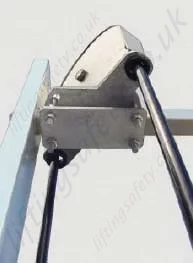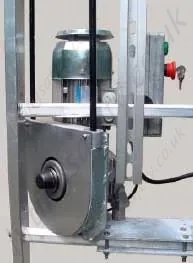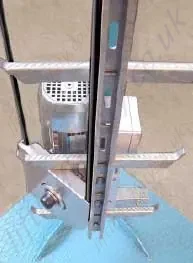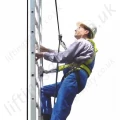
- Lifting Equipment
-
Height Safety

Height Safety Equipment
- Material Handling & Jacking Equipment
- Shop by Brand
- Clearance
-
Contact
Get In Touchsales@liftingsafety.co.uk +44 (0)1977 684 600
- Comfort, which pays!
- Relief from approx. 40 kg/80 lbs
- Saves climber’s strength
- Reduces climbing time
- Improves Operational Safety
The new Climbing Aid for vertical ladders
Velocity and Operational Safety – in this case no contradiction at all, since the Climbing Aid relieves persons climbing a ladder with a constant pulling force of approx.
40 daN (≈40kg / 80lbs), which leads to the following generally positive results:
- Less stress on arms and legs...
- The heart beat keeps closer to rest level...
- After finishing the ascent, the need to rest is decreased...
- The danger of incidents due to exhaustion is most effectively reduced...
So that, all in all, these benefits essentially improve the operational safety.
Drive and Control
A gear motor at the lower end of the ladder drives the looped belt by means of a driver disk, which is connected to the gearbox by a continuously adjustable, oil-bathlubricated sliding clutch.
The continuous welded reinforced round belt, made of special synthetic material, runs over the driver disk and the diverter pulley at the upper end of the ladder.
Switching on/off the motor is controlled by a time lag relay and switch, which is activated by a recess at the outer side of the driver pulley:
- At the first switch signal, e. g. when pulling the round belt upwards, the motor starts and keeps running, as long as the signal is repeated with each pulley revolution.
- Stopping the round belt’s movement, e. g. by breaking the ascent, the signal is not repeated within a preadjusted time lag, and the motor stops.
Universal application
Driver unit and diverter pulley are equally available for standard ladders (Figs. 1 + 3) and for ladders with middle pole (Figs. 2 + 4).
 |
 |
 |
 |
| Fig. 1 | Fig. 2 | Fig. 3 | Fig. 4 |
Connection to the belt
The harness (EN 361) is connected to the round belt by a rope grab (EN 567) with a spring snap connector (EN 362). The most effective connection is that to
the D-ring at chest level (see front page); if the harness is equipped with only one D-ring at waist level (Fig. 5), the connection can of course be done to that device.
Pricing
Unfortunately, this product has been discontinued and/or is no longer available. Please contact us for details on possible alternative products.
Contact Us About This Product- Comfort, which pays!
- Relief from approx. 40 kg/80 lbs
- Saves climber’s strength
- Reduces climbing time
- Improves Operational Safety
The new Climbing Aid for vertical ladders
Velocity and Operational Safety – in this case no contradiction at all, since the Climbing Aid relieves persons climbing a ladder with a constant pulling force of approx.
40 daN (≈40kg / 80lbs), which leads to the following generally positive results:
- Less stress on arms and legs...
- The heart beat keeps closer to rest level...
- After finishing the ascent, the need to rest is decreased...
- The danger of incidents due to exhaustion is most effectively reduced...
So that, all in all, these benefits essentially improve the operational safety.
Drive and Control
A gear motor at the lower end of the ladder drives the looped belt by means of a driver disk, which is connected to the gearbox by a continuously adjustable, oil-bathlubricated sliding clutch.
The continuous welded reinforced round belt, made of special synthetic material, runs over the driver disk and the diverter pulley at the upper end of the ladder.
Switching on/off the motor is controlled by a time lag relay and switch, which is activated by a recess at the outer side of the driver pulley:
- At the first switch signal, e. g. when pulling the round belt upwards, the motor starts and keeps running, as long as the signal is repeated with each pulley revolution.
- Stopping the round belt’s movement, e. g. by breaking the ascent, the signal is not repeated within a preadjusted time lag, and the motor stops.
Universal application
Driver unit and diverter pulley are equally available for standard ladders (Figs. 1 + 3) and for ladders with middle pole (Figs. 2 + 4).
 |
 |
 |
 |
| Fig. 1 | Fig. 2 | Fig. 3 | Fig. 4 |
Connection to the belt
The harness (EN 361) is connected to the round belt by a rope grab (EN 567) with a spring snap connector (EN 362). The most effective connection is that to
the D-ring at chest level (see front page); if the harness is equipped with only one D-ring at waist level (Fig. 5), the connection can of course be done to that device.
You May Also Like
Contact Us About This Product
If you wish to receive a quote for this product, please use the tab above, this form is for general enquiries regarding this product only.
You can also Request a Quote using the Quote tab above!
You can easily add more than one item to the Quote Request. This is highly recommended as we will be able to suit your needs much more efficiently.
Share this page!







